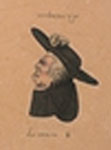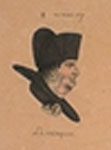

__________
| Awhole set of plates dating back to 1814-1815 shows two faces stuck neck-to-neck, one of which is Napoleon's. In this case, the Emperor (the vanquished) is blended with Louis XVIII (the victor) wearing a priest's hat. This is more an anti-royalist caricature than an anti-bonapartist one. In fact, to say that the king was victorious is excessive since he only came back following in the allies' wake. In addition, the religious hat shows clearly enough that he was identified with the reaction the French feared. This print can therefore be dated back to the Cent-Jours episode. |
__________
| Published after Napoleon's abdication on April 6, 1814, this caricature is not without reminding us of the German plate The Spanish Drink and The Russian ice-cube. Caught between fire and water, the Emperor, having taken too wide a step with his stilts, collapses in the court of Fontainebleau castle. This is one of the first plates in which Napoleon jumps or does the splits, a theme that was to be re-used in particular to illustrate his two consecutive exiles. |
__________
-Lacroix-| Riding a cat, Field-marshal Ney poses as the liberator of the rats of Saint Helena whose army is ready to fight. Liberation or invasion, that is the question that is brought up by this set of caricatures featuring cats and rats according to the rules set out by fables. In fact, the falseness of the cat and of Napoleon is obvious: Ney is about to « put a bit of flesh on his bones », by eating a few rats. |
__________
-Johann Michael Voltz-| By illustrating a German saying, this caricature represents Napoleon putting up a new army in Saint Helena. Still pictured as rats, the natives of Saint Helena are either enlisted in the Napoleonic army or enemies of the cat which stands for the Emperor (The natives of Saint Helena flee before their new sovereign). As a matter of fact, several caricatures, German and French, picture this army of rats. |
Anti-Napoléon
Napoleon body and soul
Ideology
The cosmic struggle
Great art
Popular culture